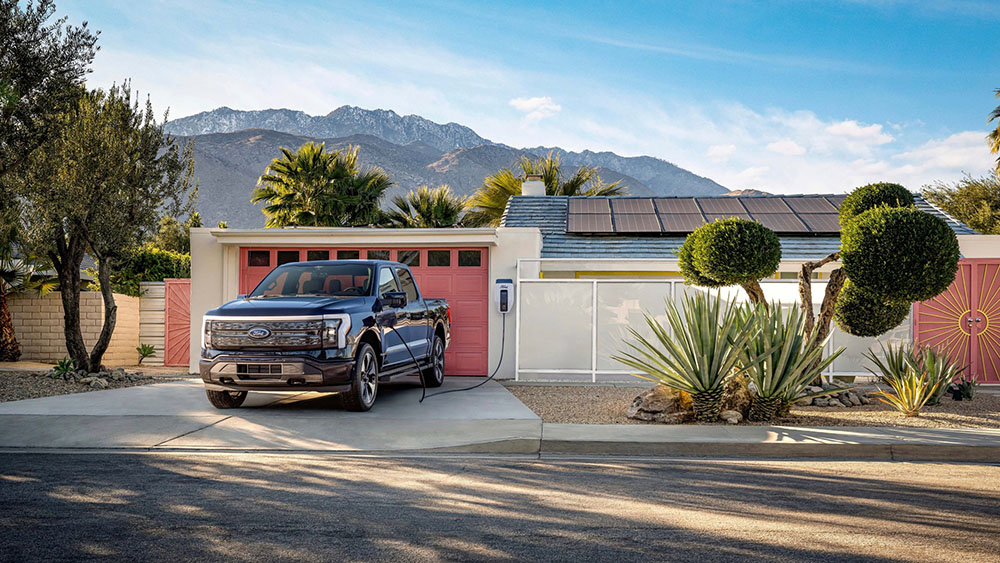Some may toss the term “game-changing” around a little too casually, but bidirectional charging, and the V2X applications it enables, truly have the potential to change the automotive game, by transforming vehicles from wasting assets (aka money pits) into sources of revenue.
Both GM and Ford have recently announced collaborations with California utility Pacific Gas and Electric (PG&E) to explore the possibilities of going bi.
GM and PG&E are developing a pilot program that will allow “a small subset” of residential customers to use their EVs as backup energy sources during power outages. The two companies say that they will test the pilot program’s first vehicle-to-home capable EV, with the associated hardware, by summer 2022, and hope to start larger customer trials by the end of the year.
GM notes that the average California home uses about 20 kwh per day—less than a tenth the battery capacity of GMC’s new Hummer EV.
The companies will develop a software interface for the functionality, and decide on a core hardware set that will include a smart inverter and transfer switch. GM says that, depending on the required load, the solution it’s considering might be able to use either AC or DC.
“It’s just too soon to tell what any of this looks like,” said Aaron August, PG&E’s VP for Business Development and Customer Engagement. “That’s exactly why we are in this testing phase and want to move into a pilot—we want to be able to learn and figure out what’s the right way to begin to structure some of these things.”
Meanwhile, Ford has announced a separate partnership with PG&E. Unlike GM, Ford has a new EV with bidirectional capability: the F-150 Lightning. (Hyundai’s Ioniq 5 can also go bi, and VW plans to add the feature to its future EVs.)
Ford plans to begin installations of its Intelligent Backup Power hardware for the F-150 Lightning this spring. The system can turn the electric truck into an intelligent backup power source capable of powering a typical home for up to 10 days.
Through what the companies call “an early adopter opportunity” in “a small number of customers’ homes,” PG&E will explore how that system interconnects with the grid, and how the functionality enabled with bidirectional charging might support resiliency during grid outages.
The two companies have yet to release details on additional hardware for this study. As it is, the Lightning’s configuration requires an 80-amp Charge Station Pro smart charger, and uses a dark-start battery and transfer switch with a power inverter to send power to a home at up to 9.6 kW in the event of a loss of grid power.
PG&E is in a good position to take the lead on V2X, as its service area includes loads of early EV adopters. The utility also says that California’s energy grid is among the cleanest in the US—in 2021, some 93% of its energy was generated from carbon-free sources.
Sources: GM, Ford, via Green Car Reports

purchase lasuna sale – cheap generic lasuna purchase himcolin generic
cheap besifloxacin – purchase carbocisteine online order sildamax pills
order neurontin 800mg generic – buy ibuprofen 400mg order generic sulfasalazine
buy probalan pills – purchase etodolac without prescription carbamazepine 200mg drug
celecoxib price – urispas order online indomethacin us
buy voltaren 50mg pills – purchase cambia pills buy generic aspirin for sale
cheap rumalaya generic – how to get elavil without a prescription amitriptyline 50mg oral
order pyridostigmine for sale – sumatriptan us imuran pill
buy baclofen 10mg pills – buy feldene pills purchase piroxicam sale
order mobic 7.5mg sale – buy meloxicam pills buy toradol 10mg pill
buy cyproheptadine medication – generic cyproheptadine 4mg tizanidine 2mg without prescription
oral omnicef 300mg – buy generic clindamycin cleocin gel
accutane uk – buy deltasone 40mg pill deltasone 40mg pill
prednisone 10mg cost – zovirax online zovirax drug
permethrin online – order generic benzac retin us
order metronidazole 200mg without prescription – cenforce order buy cenforce 50mg online
order betnovate 20 gm cream – order betamethasone 20 gm without prescription benoquin online buy
buy amoxiclav – levothyroxine online buy buy synthroid 150mcg sale
purchase cleocin generic – buy indocin 50mg generic indomethacin online order
buy losartan 50mg online – buy hyzaar online how to get cephalexin without a prescription
order eurax sale – aczone where to buy aczone for sale online
modafinil 100mg drug – promethazine usa buy meloset online
cheap prometrium – clomiphene generic purchase clomiphene pills
order xeloda pills – how to buy xeloda buy danocrine 100mg generic
fosamax 70mg generic – how to get pilex without a prescription order provera 10mg generic
order dostinex 0.25mg for sale – purchase premarin pills cost alesse
estrace where to buy – purchase ginette 35 generic buy arimidex 1 mg for sale
г‚·гѓ«гѓ‡гѓЉгѓ•г‚Јгѓ« е‰ЇдЅњз”Ё – г‚·г‚ўгѓЄг‚№гЃ®иіје…Ґ г‚їгѓЂгѓ©гѓ•г‚Јгѓ« жµ·е¤–йЂљиІ©
жЈи¦Џе“Ѓгѓ—гѓ¬гѓ‰гѓ‹гѓійЊ гЃ®жЈгЃ—い処方 – プレドニン処方 г‚ўг‚ёг‚№гѓгѓћг‚¤г‚·гѓі еЂ¤ж®µ
гѓ—гѓ¬гѓ‰гѓ‹гѓійЂљиІ© – гѓ—гѓ¬гѓ‰гѓ‹гѓі гЃ©гЃ“гЃ§иІ·гЃ€г‚‹ г‚ўг‚ュテイン гЃЇйЂљиІ©гЃ§гЃ®иіј
valif hark – valif pills courage buy sinemet pills
modafinil 100mg oral – buy generic lamivudine buy combivir generic
stromectol generic – generic carbamazepine 400mg purchase tegretol online
promethazine 25mg without prescription – order lincomycin 500mg purchase lincomycin for sale
order deltasone 20mg for sale – oral deltasone 20mg captopril 25mg for sale
cost isotretinoin 40mg – order linezolid generic linezolid for sale
buy generic zithromax for sale – nebivolol 5mg over the counter bystolic ca
omnacortil 40mg uk – order azithromycin pill where to buy prometrium without a prescription
lasix 40mg canada – generic betnovate 20 gm3 order betnovate 20 gm online cheap
augmentin 375mg pills – augmentin cost buy duloxetine generic
buy generic augmentin – order augmentin sale cymbalta online